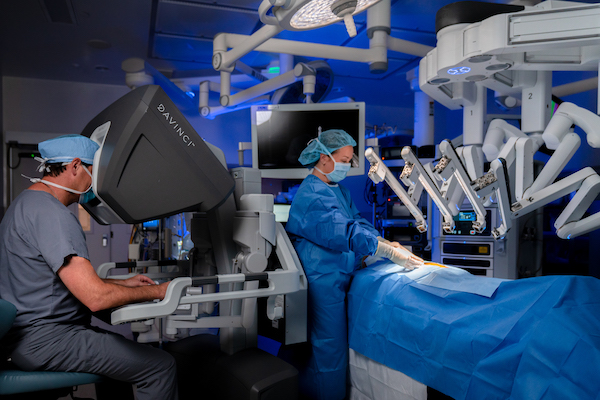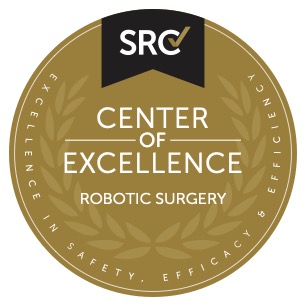Procedures Performed Using Robotic-Assisted Technology
Texoma Medical Center (TMC) was the first hospital in the region to provide robotic surgery. In recent years, robotic surgery has become an alternative to standard open surgery, as well as standard minimally invasive procedures – in fact, TMC has performed over 6,400 robotic-assisted surgeries. Potential benefits of minimally invasive robotic surgery over open surgery include a shorter hospital stay, less post-operative pain, quicker recovery, less risk of infection and less scarring.*
Schedule an appointment for robotic surgery
Please complete our general appointment form or call our referral service at 903‑416‑3627.
Robotic systems used at Texoma Medical Center
 Specially-trained surgeons at the Center for Robotic Surgery at Texoma Medical Center perform procedures using different robotics systems, including:
Specially-trained surgeons at the Center for Robotic Surgery at Texoma Medical Center perform procedures using different robotics systems, including:
- da Vinci® Xi® Surgical System
- Mako SmartRobotics™
- Ion Endoluminal System
da Vinci Xi Surgical System
The da Vinci Xi Surgical System is used for gynecologic procedures, kidney surgery, gallbladder surgery, hernia surgery, thoracic surgery and weight-loss surgery. It uses advanced robotic technology to provide a 3D depth of field and enable a surgeon's hand movements to be translated into precise micro-movements of tiny instruments at the operative site. High-definition visualization enables the surgeon to perform complex procedures through dime-sized operating "ports" in the body.
Mako SmartRobotics
Mako SmartRobotics is primarily used for Total Knee and Partial Knee Replacement surgery. It helps to provides relief for pain caused by arthritis and joint degeneration. The Mako system helps to create a 3D model of affected joints to more accurately create a treatment plan. There are many different treatment options available, so talk to your Orthopedic Surgeon to find out if Mako SmartRobotics is the right treatment option for you.
Ion Endoluminal System
Pulmonologists at Texoma Medical Center perform robotic-assisted bronchoscopies with the Ion system for patients who have suspicious lung nodules. Ion utilizes an ultra-thin, robotically assisted catheter. This catheter can collect deeper tissues samples than traditional lung biopsies, with more minimal side effects.
Center of Excellence in Robotic Surgery
 Texoma Medical Center achieved accreditation from Surgical Review Corporation (SRC) as a Center of Excellence in Robotic Surgery. This accreditation recognizes TMC’s commitment and high standard of delivery of quality patient care and safety.
Texoma Medical Center achieved accreditation from Surgical Review Corporation (SRC) as a Center of Excellence in Robotic Surgery. This accreditation recognizes TMC’s commitment and high standard of delivery of quality patient care and safety.
Types of Robotic Assisted Surgeries
Robotic gynecologic surgery
For some women, robotic gynecologic surgery may be a good alternative to open surgery or standard laparoscopic procedures. Open gynecologic surgery, in which a large incision is made in the abdomen so a surgeon can access the uterus and surrounding anatomy, has been the standard approach to gynecologic procedures for years. However, open surgery can cause significant pain, physical trauma and a long recovery process. The potential advantages of laparoscopic and robotic-assisted laparoscopic hysterectomy and other gynecologic procedures over conventional open surgery include smaller incisions, which may result in less post-operative pain, reduced blood loss and less need for blood transfusions, and a potentially faster recovery and return to normal activities.
Hysterectomy
Hysterectomy is the removal of a woman's uterus. A hysterectomy may be recommended for a number of conditions including cancer, uterine fibroids (non-cancerous tumors), endometriosis, chronic pelvic pain or abnormal vaginal bleeding. A robotic hysterectomy with the da Vinci Surgical System allows doctors to perform precise, minimally invasive procedures with a few small incisions in the abdomen.
In some cases, only one incision — in the navel (belly button) — is made to remove the uterus. Known as da Vinci Single-Site® robotic surgery, this is a refinement to the standard da Vinci system. Because there is only a single, small incision, patients often experience less trauma to the body and less blood loss during the procedure surgery. This means they may recover more quickly and return to work and daily activities faster than they would with conventional surgery.
Myomectomy
A robotic myomectomy procedure can be used to remove uterine fibroids while preserving a patient's uterus. Fibroids are non-cancerous tumors that grow within or outside the uterus and can contribute to infertility and miscarriages. After using the da Vinci Surgical System to remove each fibroid, surgeons carefully repair the uterus to minimize potential bleeding, infection and scarring.
Salpingectomy
A salpingectomy is performed to remove one or both of the fallopian tubes. This may be needed when the patient has fallopian tube cancer, ovarian cancer, an ectopic pregnancy, endometriosis, or a blocked or infected fallopian tube.
Oophorectomy
An oophorectomy is performed to remove one or both ovaries. This is normally done to remove an ovarian cyst, when a patient has a family history of ovarian cancer, or to treat other problems such as endometriosis.
Ovarian Cystectomy
This procedure is performed to remove a cyst from an ovary. This may be needed if the cyst does not go away on its own or gets larger.
Robotic general surgery
Single-Site Cholecystectomy (gallbladder removal)
Treatment for gallbladder disease generally includes lifestyle and dietary changes and medication. However, in some cases, doctors recommend cholecystectomy, which is surgery to remove the gallbladder.
Although minimally invasive cholecystectomy has been used for several years, a new surgical refinement, in which only one incision - in the navel (belly button) - is made to perform the surgery. Because there is only a single, small incision with da Vinci Single-Site robotic surgery. Patients often experience less trauma to the body and less blood loss during the procedure surgery. This means they may recover more quickly and return to work and daily activities faster than they would with conventional surgery.
Hernia surgery
A hernia happens when part of an internal organ or tissue bulges through a weak area in the belly wall or groin. A combination of muscle weakness and straining, such as heavy lifting, may cause hernias. Some people are born with hernias or with weak abdominal muscles and some people have a family history of hernia. Surgery is considered the only way to permanently fix a hernia. Surgeons at TMC use the da Vinci Surgical System to correct hernias so patients have less post-operative pain and a quicker recovery.
Colon resection surgeries (Hemicolectomy and Sigmoid Colectomy)
A colon resection surgery, or colectomy, is performed to remove sections of the large intestine that have become diseased from colon cancer, diverticulitis, infection, or other conditions. During the surgery, the diseased section is removed and then the healthy parts of the bowel are reconnected. Small incisions are made in the abdomen and a scope and surgical instruments are inserted to perform the procedure.
Weight-loss surgery
Robotic-assisted surgery at Texoma Medical Center is our latest tool to assist patients in their weight-loss journey. Bariatric surgeons are trained on the da Vinci Xi Surgical System, and these advanced robotic platforms allow doctors to perform complex procedures using smaller incisions than standard surgery with tiny, precision tools operated robotically
Thoracic surgery
Surgeries that take place in the chest can be invasive, requiring long incisions. However, a robotic-assisted, minimally invasive thoracic surgery only requires a few small incisions that can enable a doctor to see a complete view of your anatomy.
We perform the following robotic-assisted thoracic surgeries:
- Lung biopsy
- Lung surgery: Lobectomy/Bi-lobectomy/Wedge resection
- Mediastinal mass resection
- Thymectomy
- Tumors of the chest cavity
Orthopedic surgery
Orthopedic surgery can help replace and repair damaged joints and bones. Currently, Texoma offers two types of robotic-assisted orthopedic surgical options:
- Total Knee Replacement
- Knee Resurfacing
Robotic-assisted orthopedic surgeries can help doctors create a more accurate plan for joint replacement and assistance through 3D imaging assistance.
*Individual results may vary. There are risks associated with any surgical procedure. Talk with your doctor about these risks to find out if robotic surgery or minimally invasive surgery are right for you.
